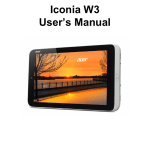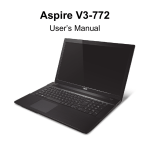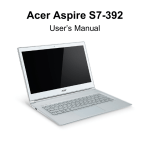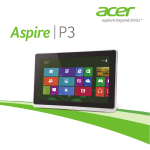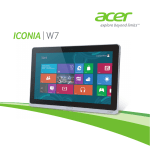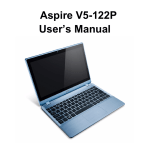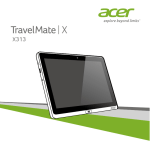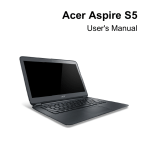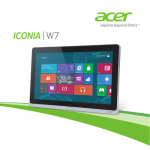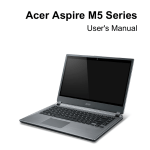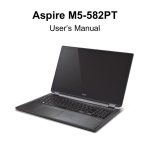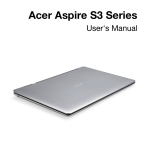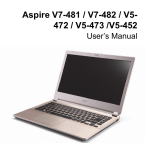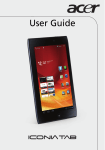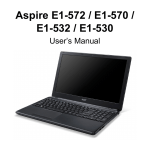Download ICONIA W510 / W511 User`s Manual
Transcript
ICONIA W510 / W511 User’s Manual - 1 © 2012. All Rights Reserved. ICONIA W510 / W511 User’s Manual Model: W510 First issue: 6 November 2012 2- T ABLE O F CONTENTS Safety and comfort First things first 5 Micro USB 30 15 HDMI Micro 31 Your guides ...................................................... 15 Basic care and tips for using your computer .......................................................... 15 Turning your computer on and off............. 15 Taking care of your computer ................... 16 Taking care of your AC adapter ................ 17 Cleaning and servicing.............................. 17 Your Acer tablet PC tour Using the virtual keyboard 32 Wireless networks 34 Connecting to the Internet ............................... 34 Wireless networks ........................................... 34 Acer clear.fi 36 18 Navigating media and photos .......................... 36 Tablet PC ......................................................... 18 Top view ................................................... 18 Bottom view ............................................. 19 Front view ................................................ 20 Back view ................................................. 21 Left/right views ........................................ 22 Installing a SIM card (only for selected models) ............................................................ 23 Using the network connection................... 23 SIM card lock ............................................ 24 Removing the SIM card ............................ 24 Connect the tablet to the keyboard dock.......... 25 Secure the tablet to the keyboard dock .......................................................... 25 Keyboard dock ................................................. 26 Front view ................................................ 26 Top view ................................................... 27 Left view.................................................... 28 Right view ................................................. 28 Bottom view ............................................. 29 Shared files .............................................. 37 Which devices are compatible? ............... 37 Playing to another device......................... 38 Screen orientation and G-sensor 39 Power management 40 Saving power................................................... 40 Battery pack 43 Battery pack characteristics............................. Charging the battery................................. Optimizing battery life............................... Checking the battery level........................ Battery-low warning.................................. 43 43 45 45 45 Securing your computer 47 Using passwords ............................................. 47 Entering passwords.................................. 48 Frequently asked questions 49 Requesting service .......................................... 51 Tips and hints for using Windows 8................. 53 Table of contents - 3 Three concepts you might want to keep in mind.............................................. 53 How do I access the charms?................... 53 How do I get to Start? ............................... 53 How do I jump between apps?.................. 54 How do I turn off my computer?................ 54 Why is there a new interface?................... 54 How do I unlock my computer?................. 54 How do I personalize my computer?......... 55 I want to use Windows in the way that I'm used to - give me my desktop back!............................................ 56 Where are my apps?................................. 56 What is a Microsoft ID (account)?............. 58 How do I add a favorite to Internet Explorer?................................................... 58 How do I check for Windows updates? ................................................... 59 Where can I get more information?........... 59 Troubleshooting ............................................... 60 Troubleshooting tips.................................. 60 4 - Table of contents Error messages........................................ 60 Recovering your system 62 Recovery from a supplied recovery DVD ........ 62 Recovery 63 Creating a recovery backup............................. Creating a drivers and applications backup..... Recovering your system .................................. Reinstalling drivers and applications........ Returning to an earlier system snapshot................................................... Returning your system to its factory condition................................................... Recovering from Windows ....................... Recovering from a recovery backup ........ 63 66 69 70 BIOS utility 83 73 74 75 79 Boot sequence................................................. 83 Setting passwords ........................................... 83 Regulations and safety notices 84 S AFETY AND COMFORT SAFETY INSTRUCTIONS Read these instructions carefully. Keep this document for future reference. Follow all warnings and instructions marked on the product. Turning the product off before cleaning Unplug this product from the wall outlet before cleaning. Do not use liquid cleaners or aerosol cleaners. Use a damp cloth for cleaning. WARNINGS Accessing the power cord Be sure that the power outlet you plug the power cord into is easily accessible and located as close to the equipment operator as possible. When you need to disconnect power to the equipment, be sure to unplug the power cord from the electrical outlet. Disconnecting the power source Observe the following guidelines when connecting and disconnecting power to the power supply unit: Install the power supply unit before connecting the power cord to the AC power outlet. Unplug the power cord before removing the power supply unit from the computer. If the system has multiple sources of power, disconnect power from the system by unplugging all power cords from the power supplies. Using electrical power - This product should be operated from the type of power indicated on the marking label. If you are not sure of the type of power available, consult your dealer or local power company. - Do not allow anything to rest on the power cord. Do not locate this product where people will walk on the cord. Safety and comfort - 5 - If an extension cord is used with this product, make sure that the total ampere rating of the equipment plugged into the extension cord does not exceed the extension cord ampere rating. Also, make sure that the total rating of all products plugged into the wall outlet does not exceed the fuse rating. - Do not overload a power outlet, strip or receptacle by plugging in too many devices. The overall system load must not exceed 80% of the branch circuit rating. If power strips are used, the load should not exceed 80% of the power strip's input rating. - This product's AC adapter is equipped with a three-wire grounded plug. The plug only fits in a grounded power outlet. Make sure the power outlet is properly grounded before inserting the AC adapter plug. Do not insert the plug into a non-grounded power outlet. Contact your electrician for details. - Warning! The grounding pin is a safety feature. Using a power outlet that is not properly grounded may result in electric shock and/or injury. - Note: The grounding pin also provides good protection from unexpected noise produced by other nearby electrical devices that may interfere with the performance of this product. - The system can be powered using a wide range of voltages; 100 to 120 or 220 to 240 V AC. The power cord included with the system meets the requirements for use in the country/region where the system was purchased. Power cords for use in other countries/regions must meet the requirements for that country/region. For more information on power cord requirements, contact an authorized reseller or service provider. Protecting your hearing - Warning! Permanent hearing loss may occur if earphones or headphones are used at high volume for prolonged periods of time. To protect your hearing, follow these instructions. - Increase the volume gradually until you can hear clearly and comfortably. - Do not increase the volume level after your ears have adjusted. - Do not listen to music at high volumes for extended periods. 6 - Safety and comfort - Do not increase the volume to block out noisy surroundings. - Decrease the volume if you can't hear people speaking near you. Bundled dummy cards - Note: Information in this section may not apply to your computer. Your computer shipped with plastic dummies installed in the card slots. Dummies protect unused slots from dust, metal objects or other particles. Save the dummies for use when no cards are in the slots. General - Do not use this product near water. - Do not place this product on an unstable cart, stand or table. If the product falls, it could be seriously damaged. - Slots and openings are provided for ventilation to ensure reliable operation of the product and to protect it from overheating. These openings must not be blocked or covered. The openings should never be blocked by placing the product on a bed, sofa, rug or other similar surface. This product should never be placed near or over a radiator or heat register, or in a built-in installation unless proper ventilation is provided. - Never push objects of any kind into this product through cabinet slots as they may touch dangerous voltage points or short-out parts that could result in a fire or electric shock. Never spill liquid of any kind onto or into the product. - To avoid damage of internal components and to prevent battery leakage, do not place the product on a vibrating surface. - Never use it under sporting, exercising, or any vibrating environment which will probably cause unexpected short current or damage rotor devices, HDD, Optical drive, and even exposure risk from lithium battery pack. - The bottom surface, areas around ventilation openings and AC adapter may get hot. To avoid injury, ensure they do not come in contact with your skin or body. - Your device and its enhancements may contain small parts. Keep them out of the reach of small children. Safety and comfort - 7 Product servicing Do not attempt to service this product yourself, as opening or removing covers may expose you to dangerous voltage points or other risks. Refer all servicing to qualified service personnel. Unplug this product from the wall outlet and refer servicing to qualified service personnel when: - The power cord or plug is damaged, cut or frayed. - Liquid was spilled into the product. - The product was exposed to rain or water. - The product has been dropped or the case has been damaged. - The product exhibits a distinct change in performance, indicating a need for service. - The product does not operate normally after following the operating instructions. - Note: Adjust only those controls that are covered by the operating instructions, since improper adjustment of other controls may result in damage and will often require extensive work by a qualified technician to restore the product to normal condition. Guidelines for safe battery usage This computer uses a Lithium-ion or Lithium-polymer battery. Do not use it in a humid, wet or corrosive environment. Do not put, store or leave your product in or near a heat source, in a high temperature location, in strong direct sunlight, in a microwave oven or in a pressurized container, and do not expose it to temperatures over 60° C (140° F). Failure to follow these guidelines may cause the battery to leak acid, become hot, explode or ignite and cause injury and/or damage. Do not pierce, open or disassemble the battery. If the battery leaks and you come into contact with the leaked fluids, rinse thoroughly with water and seek medical attention immediately. For safety reasons, and to prolong the lifetime of the battery, charging will not occur at temperatures below 0° C (32° F) or above 40° C (104° F). 8 - Safety and comfort The full performance of a new battery is achieved only after two or three complete charge and discharge cycles. The battery can be charged and discharged hundreds of times, but it will eventually wear out. When the operation time becomes noticeably shorter than normal, refer to qualified service personnel. Use only the approved batteries, and recharge your battery only with the approved chargers designated for this device. Never use any charger or battery that is damaged. The capacity and lifetime of the battery will be reduced if the battery is left in hot or cold places, such as in a closed car in summer or winter. Always try to keep the battery between 15°C and 25°C (59°F and 77°F). A device with a hot or cold battery may not work temporarily, even when the battery is fully charged. Battery performance is especially limited in temperatures well below freezing. Do not dispose of batteries in a fire as they may explode. Batteries may also explode if damaged. Dispose of batteries according to local regulations. Please recycle when possible. Do not dispose as household waste. - Note: Please refer to www.acer.com for battery shipping documents. - Warning! Batteries may explode if not handled properly. Do not disassemble or dispose of them in fire. Keep them away from children. Follow local regulations when disposing of used batteries. RADIO FREQUENCY INTERFERENCE - Warning! For safety reasons, turn off all wireless or radio transmitting devices when using your laptop under the following conditions. These devices may include, but are not limited to: wireless LAN (WLAN), Bluetooth and/or 3G. Remember to follow any special regulations in force in any area, and always switch off your device when its use is prohibited or when it may cause interference or danger. Use the device only in its normal operating positions. This device meets RF exposure guidelines when used normally, and it and its antenna are positioned at least 1.5 centimeters (5/8 inch) away from your body. It should not contain metal and you should position the device the above-stated distance from your body. To successfully transmit data files or messages, this device requires a good quality connection to the network. In Safety and comfort - 9 some cases, transmission of data files or messages may be delayed until such a connection is available. Ensure that the above separation distance instructions are followed until the transmission is completed. Parts of the device are magnetic. Metallic materials may be attracted to the device, and persons with hearing aids should not hold the device to the ear with the hearing aid. Do not place credit cards or other magnetic storage media near the device, because information stored on them may be erased. MEDICAL DEVICES Operation of any radio transmitting equipment, including wireless phones, may interfere with the functionality of inadequately protected medical devices. Consult a physician or the manufacturer of the medical device to determine if they are adequately shielded from external RF energy or if you have any questions. Switch off your device in health care facilities when any regulations posted in these areas instruct you to do so. Hospitals or health care facilities may be using equipment that could be sensitive to external RF transmissions. Pacemakers. Pacemaker manufacturers recommend that a minimum separation of 15.3 centimeters (6 inches) be maintained between wireless devices and a pacemaker to avoid potential interference with the pacemaker. These recommendations are consistent with the independent research by and recommendations of Wireless Technology Research. Persons with pacemakers should do the following: - Always keep the device more than 15.3 centimeters (6 inches) from the pacemaker - Not carry the device near your pacemaker when the device is switched on. If you suspect interference, switch off your device, and move it. Hearing aids. Some digital wireless devices may interfere with some hearing aids. If interference occurs, consult your service provider. VEHICLES RF signals may affect improperly installed or inadequately shielded electronic systems in motor vehicles such as electronic fuel injection systems, electronic anti-skid (anti-lock) braking systems, electronic speed control systems, and air bag systems. For more information, check with the manufacturer, or its representative, of your vehicle or any 10 - Safety and comfort equipment that has been added. Only qualified personnel should service the device, or install the device in a vehicle. Faulty installation or service may be dangerous and may invalidate any warranty that may apply to the device. Check regularly that all wireless equipment in your vehicle is mounted and operating properly. Do not store or carry flammable liquids, gases, or explosive materials in the same compartment as the device, its parts, or enhancements. For vehicles equipped with an air bag, remember that air bags inflate with great force. Do not place objects, including installed or portable wireless equipment in the area over the air bag or in the air bag deployment area. If in-vehicle wireless equipment is improperly installed, and the air bag inflates, serious injury could result. Using your device while flying in aircraft is prohibited. Switch off your device before boarding an aircraft. The use of wireless teledevices in an aircraft may be dangerous to the operation of the aircraft, disrupt the wireless telephone network, and may be illegal. POTENTIALLY EXPLOSIVE ENVIRONMENTS Switch off your device when in any area with a potentially explosive atmosphere and obey all signs and instructions. Potentially explosive atmospheres include areas where you would normally be advised to turn off your vehicle engine. Sparks in such areas could cause an explosion or fire resulting in bodily injury or even death. Switch off the device at refueling points such as near gas pumps at service stations. Observe restrictions on the use of radio equipment in fuel depots, storage, and distribution areas; chemical plants; or where blasting operations are in progress. Areas with a potentially explosive atmosphere are often, but not always, clearly marked. They include below deck on boats, chemical transfer or storage facilities, vehicles using liquefied petroleum gas (such as propane or butane), and areas where the air contains chemicals or particles such as grain, dust or metal powders. Do not switch the computer on when wireless phone use is prohibited or when it may cause interference or danger. EMERGENCY CALLS - Warning! You cannot make emergency calls through this device. To make an emergency call you shall dial out through your mobile phone or other telephone call system. Safety and comfort - 11 DISPOSAL INSTRUCTIONS Do not throw this electronic device into the trash when discarding. To minimize pollution and ensure utmost protection of the global environment, please recycle. For more information on the Waste from Electrical and Electronics Equipment (WEEE) regulations, visit www.acer-group.com/public/ Sustainability/sustainability01.htm TIPS AND INFORMATION FOR COMFORTABLE USE Computer users may complain of eyestrain and headaches after prolonged use. Users are also at risk of physical injury after long hours of working in front of a computer. Long work periods, bad posture, poor work habits, stress, inadequate working conditions, personal health and other factors greatly increase the risk of physical injury. Incorrect computer usage may lead to carpal tunnel syndrome, tendonitis, tenosynovitis or other musculoskeletal disorders. The following symptoms may appear in the hands, wrists, arms, shoulders, neck or back: - Numbness, or a burning or tingling sensation. - Aching, soreness or tenderness. - Pain, swelling or throbbing. - Stiffness or tightness. - Coldness or weakness. If you have these symptoms, or any other recurring or persistent discomfort and/or pain related to computer use, consult a physician immediately and inform your company's health and safety department. The following section provides tips for more comfortable computer use. Finding your comfort zone Find your comfort zone by adjusting the viewing angle of the monitor, using a footrest, or raising your sitting height to achieve maximum comfort. Observe the following tips: - Refrain from staying too long in one fixed posture. - Avoid slouching forward and/or leaning backward. 12 - Safety and comfort - Stand up and walk around regularly to remove the strain on your leg muscles. - Take short rests to relax your neck and shoulders. - Avoid tensing your muscles or shrugging your shoulders. - Install the external display, keyboard and mouse properly and within comfortable reach. - If you view your monitor more than your documents, place the display at the center of your desk to minimize neck strain. Taking care of your vision Long viewing hours, wearing incorrect glasses or contact lenses, glare, excessive room lighting, poorly focused screens, very small typefaces and low-contrast displays could stress your eyes. The following sections provide suggestions on how to reduce eyestrain. Eyes - Rest your eyes frequently. - Give your eyes regular breaks by looking away from the monitor and focusing on a distant point. - Blink frequently to keep your eyes from drying out. Display - Keep your display clean. - Keep your head at a higher level than the top edge of the display so your eyes point downward when looking at the middle of the display. - Adjust the display brightness and/or contrast to a comfortable level for enhanced text readability and graphics clarity. - Eliminate glare and reflections by: placing your display in such a way that the side faces the window or any light source, minimizing room light by using drapes, shades or blinds, using a task light, changing the display's viewing angle, Safety and comfort - 13 using a glare-reduction filter, using a display visor, such as a piece of cardboard extended from the display's top front edge. - Avoid adjusting your display to an awkward viewing angle. - Avoid looking at bright light sources for extended periods of time. Developing good work habits The following work habits make computer use more relaxing and productive: - Take short breaks regularly and often. - Perform some stretching exercises. - Breathe fresh air as often as possible. - Exercise regularly and maintain a healthy body. - Warning! We do not recommend using the computer on a couch or bed. If this is unavoidable, work for only short periods, take breaks regularly, and do some stretching exercises. - Note: For more information, please refer to "Regulations and safety notices" on page 84. ENVIRONMENT Temperature - Operating: 5 °C to 35 °C - Non-operating: -20 °C to 65 °C Humidity (non-condensing) - Operating: 20% to 80% - Non-operating: 20% to 80% 14 - Safety and comfort F IRST THINGS F I R S T We would like to thank you for making an Acer notebook your choice for meeting your mobile computing needs. Your guides To help you use your Acer notebook, we have designed a set of guides: First off, the setup poster helps you get started with setting up your computer. The Quick Guide introduces you to the basic features and functions of your new computer. For more on how your computer can help you to be more productive, please refer to the User’s Manual. This guide contains detailed information on such subjects as system utilities, data recovery, expansion options and troubleshooting. In addition it contains general regulations and safety notices for your notebook. It is available from Desktop; double-click the Help icon and click User’s Manual in the menu that opens. Basic care and tips for using your computer Turning your computer on and off To turn the power off, do any of the following: • Use the Windows shutdown command: Press the Windows key + <C>, click Settings > Power then click Shut Down. First things first - 15 If you need to power down the computer for a short while, but don’t want to completely shut it down, you can put it into Hibernate by pressing the power button. Note: If you cannot power off the computer normally, press and hold the power button for more than four seconds to shut down the computer. If you turn off the computer and want to turn it on again, wait at least two seconds before powering up. Taking care of your computer Your computer will serve you well if you take care of it. • Do not expose the computer to direct sunlight. Do not place it near sources of heat, such as a radiator. • Do not expose the computer to temperatures below 0º C (32º F) or above 50º C (122º F). • Do not subject the computer to magnetic fields. • Do not expose the computer to rain or moisture. • Do not spill water or any liquid on the computer. • Do not subject the computer to heavy shock or vibration. • Do not expose the computer to dust or dirt. • Never place objects on top of the computer. • Do not slam the computer display when you close it. • Never place the computer on uneven surfaces. 16 - First things first Taking care of your AC adapter Here are some ways to take care of your AC adapter: • Do not connect the adapter to any other device. • Do not step on the power cord or place heavy objects on top of it. Carefully route the power cord and any cables away from foot traffic. • When unplugging the power cord, do not pull on the cord itself but pull on the plug. • The total ampere ratings of the equipment plugged in should not exceed the ampere rating of the cord if you are using an extension cord. Also, the total current rating of all equipment plugged into a single wall outlet should not exceed the fuse rating. Cleaning and servicing When cleaning the computer, follow these steps: 1. Turn off the computer. 2. Disconnect the AC adapter. 3. Use a soft, moist cloth. Do not use liquid or aerosol cleaners. If either of the following occurs: • The computer has been dropped or the body has been damaged; • The computer does not operate normally Please refer to "Frequently asked questions" on page 49. First things first - 17 Y OU R A CER T ABL ET PC TOUR After setting up your computer as illustrated in the setup poster, let us show you around your new Acer computer. You can enter information into you new computer with the touchscreen. Tablet PC Your tablet computer has two components: the tablet and an optional keyboard dock. The following images will show you both of these. Top view 1 No. Item 1 2 3 2 3 Description Connects to audio devices Headset/speaker (e.g., speakers, headphones) or a headset with jack microphone. Lock switch Locks the screen orientation. Press to turn the tablet on; press again to place Power button the tablet in Sleep mode. Press and hold to turn the tablet off. Battery LED Indicates the tablet's power status. 18 - Your Acer tablet PC tour Note: Display orientation may be fixed when apps designed for a specific orientation are running. These include games and other fullscreen apps. When making video calls, you should always hold the tablet in landscape orientation. LED Indicators LED color State Blue Steady Amber Steady Description The computer is fully charged and plugged in. The computer is charging and plugged in. Bottom view 1 2 No. Item Description Slot for keyboard Fastens to the keyboard dock. 1 dock Dock connector / 2 Connects to an AC adapter or the keyboard dock. DC-in Your Acer tablet PC tour - 19 Front view 1 2 No. Item Integrated 1 webcam 2 Windows key 20 - Your Acer tablet PC tour Description Web camera for video communication. Press once to open the Start menu. Back view 1 2 3 4 No. 1 2 Item Flash Camera indicator light 3 Camera 4 NFC (optional) Description LED flash for camera. Lights up when camera is active. 8-megapixel camera for taking high-resolution images. NFC contact area. Not available on all models. Your Acer tablet PC tour - 21 Left/right views 2 3 4 5 6 1 No. Item 1 Speakers 2 Volume key 3 Micro HDMI port 4 Micro USB connector 22 - Your Acer tablet PC tour Description Delivers stereo audio output. Press to increase or decrease volume. Supports high-definition digital video connections. Connects to USB devices. A Micro USB to USB adapter is needed to connect to USB devices. When using a USB port, it is recommended to plug in the power adapter. No. Item Description 5 MicroSD card slot Insert a microSD card into this slot. Insert a SIM card into this slot. 6 SIM card slot* * - only for selected models. Installing a SIM card (only for selected models) Certain computers include a SIM slot for Internet access. To take full advantage of your computer’s Internet capabilities, you should install a SIM card with data subscription before turning on your computer. 1. Make sure your computer is turned off. 2. Insert the SIM card. When fully inserted, the SIM card will click into place. 3. Turn on your computer. Note: Ensure that the SIM card is inserted all the way into the card slot. Caution: Turn off your computer before installing or removing a SIM card. You may damage the card or your computer if power it still on. Using the network connection Open the desktop and tap the network icon in the taskbar. Your Acer tablet PC tour - 23 Select your data connection from the list of networks. Select Connect, then Next. SIM card lock Your computer may come with a SIM card lock, i.e., you will only be able to use the SIM card provided by your network operator. To cancel the SIM lock, contact your network provider. Removing the SIM card 1. Make sure your computer is turned off. 2. Press the SIM card into the slot then carefully release. The SIM card will be pushed out of the slot. 24 - Your Acer tablet PC tour Connect the tablet to the keyboard dock The keyboard dock is optional. Align the tablet with the dock connector and two pins on the keyboard dock. Press the tablet down until the release latch clicks into place. Secure the tablet to the keyboard dock Place the tablet on the dock, ensuring it clicks into place. Note: Push the release latch to the left and lift the tablet to remove it from the keyboard dock. Your Acer tablet PC tour - 25 Keyboard dock The following set of images show you the optional keyboard dock. Front view 1 2 No. Item Pin for keyboard 1 dock 2 Dock connector 26 - Your Acer tablet PC tour Description Secures the tablet to the dock. Connects to the dock connector on the tablet. Top view 1 2 3 No. Item Battery and power 1 indicators 2 Keyboard 3 Touchpad Description Indicates the tablet's power status. For entering data into your tablet. Touch-sensitive pointing device. Note: The additional internal battery is not available in all models of the keyboard dock. LED Indicators LED color State Blue Steady Amber Steady Description The computer is fully charged and plugged in. The computer is charging and plugged in. Your Acer tablet PC tour - 27 Left view 1 No. Item 1 DC-in Description Connects to an AC adapter. Right view 1 No. Item 1 USB 2.0 port 28 - Your Acer tablet PC tour Description Connect to USB devices. Bottom view 1 No. Item 1 Release latch Description Secures the tablet to the keyboard dock until opened. Your Acer tablet PC tour - 29 M ICRO USB The USB (Universal Serial Bus) port is a high-speed serial bus which allows you to connect USB peripherals without taking up system resources. The Micro USB port provides a compact port that is fully compatible with USB 2.0 devices. Note: A Micro USB to USB adapter is needed to connect to USB devices that use a full-sized connector. Note: A Micro USB to USB adapter is only included with certain models. 30 - Micro USB H D M I M ICRO HDMI (High-Definition Multimedia Interface) is an industry-supported, uncompressed, all-digital audio/video interface. HDMI provides an interface between any compatible digital audio/video source, such as a set-top box, DVD player, and A/V receiver and a compatible digital audio and/or video monitor, such as a digital television (DTV), over a single cable. Use the HDMI Micro port on your computer to connect with high-end audio and video equipment. Single cable implementation allows tidy setup and fast connection. Note: A HDMI Micro to HDMI adapter is only included with certain models. HDMI Micro - 31 U S I N G T H E VIRTUAL K E Y B O A R D Microsoft Windows provides a convenient virtual keyboard for entering data. There are several ways to display the keyboard: Tap inside any text field to display the Windows virtual keyboard. 32 - Using the virtual keyboard From Desktop, tap the Keyboard icon in the system tray to display the keyboard. Tap the "x" in the keyboard’s top-right corner to close the keyboard. Using the virtual keyboard - 33 W IRELESS N E TW ORK S Connecting to the Internet Your computer's wireless connection is turned on by default. Windows will detect and display a list of available networks during setup. Select your network and enter the password if required. Otherwise, open Internet Explorer and follow the instructions. Please refer to your ISP or router documentation. Wireless networks A wireless LAN or WLAN is a wireless local area network, which may link two or more computers without using wires. Setting up a wireless network is easy and allows you to share files, peripheral devices and an Internet connection. What are benefits of a wireless network? Mobility Wireless LAN systems allow you and other users of your home network to share access to files and devices connected to the network, for example a printer or scanner. Also you can share an internet connection with other computers in your home. 34 - Wireless networks Installation speed and simplicity Installing a wireless LAN system can be fast and easy and eliminates the need to pull cables through walls and ceilings. Components of a wireless LAN To set up your Wireless network at home you need to have the following: Access point (router) Access points (routers) are two-way transceivers that broadcast data into the surrounding environment. Access points act as a mediator between wired and wireless network. Most routers have a built-in DSL modem that will allow you access to a high speed DSL internet connection. The ISP (Internet Service Provider) you have chosen normally supplies a modem/router with the subscription to their services. Read carefully the documentation supplied with your Access point/router for detailed setup instructions. Wireless networks - 35 A CER CLEAR . FI Note: Only for certain models. With Acer clear.fi, you can enjoy videos, photos and music. Stream media from, or to, other devices with Acer clear.fi installed. Note: All devices must be connected to the same network. To watch videos or listen to music open clear.fi Media, to browse photos open clear.fi Photo. Important: When you first open a clear.fi application, Windows Firewall will ask for permission to allow clear.fi to access the network. Select Allow Access in each window. Navigating media and photos The list in the left panel shows your computer (’My Library’), then other devices if any are connected to your network (’Home Shared’). To view files on your computer, select one of the categories under ’My Library’, then browse the files and folder on the right. 36 - Acer clear.fi Shared files Devices connected to your network are shown in the Home Shared section. Select a device, then select the category to explore. After a short delay, shared files and folders are shown on the right. Browse to the file you want to play, then double-click to start playback. Use the media controls in the bar across the bottom of the screen to control playback. For example, when music is selected, you can play, pause or stop playback, and adjust the volume. Note: You must activate sharing on the device that stores the files. Open clear.fi on the device that stores the files, select Edit then make sure Share my library on local network is active. Which devices are compatible? Most devices with clear.fi or DLNA software can be used with the clear.fi software. These include DLNA-compliant PCs, smartphones, and NAS (Network Attached Storage) devices. Acer clear.fi - 37 Note: DLNA is an standard that allows devices connected to a home network to communicate and share files. Playing to another device If you want to play the media on another device, you need to do the following: 1. In the bottom right corner, select Play to. 2. Select the remote device that will be used to play the file. Note: Only devices optimised for playback are available in this list, certain PCs and storage devices will not appear. To add a Windows PC to this list, open Windows Media Player, select Stream and Allow remote control of my Player... 3. Select a file in the main window, then use the media controls in the bar across the bottom of the screen to control the remote device. For more help, go to http://www.acer.com/clearfi/download/. 38 - Acer clear.fi S CREEN OR IENTATION AND G- SENSOR Your computer has a built-in accelerometer that detects the tablet’s orientation and automatically rotates the screen to suit the orientation. You can lock the screen orientation by using the lock switch. The orientation may also be locked at other times, including: • When the tablet is attached to a dock or cradle. • With an HDMI cable is plugged in. • When programs designed for a specific orientation are running. Note: You are advised to keep your tablet in landscape orientation with the webcam above the screen while you are making a video call. Please rotate your display to the landscape orientation and use the lock switch to set the orientation before starting a video call. The screen orientation lock status will be indicated via icons briefly displayed onscreen when the status changes. Screen orientation and G-sensor - 39 P OWER MANAGEMENT This computer has a built-in power management unit that monitors system activity. System activity refers to any activity involving one or more of the following devices: keyboard, mouse, hard disk, peripherals connected to the computer, and video memory. If no activity is detected for a period of time, the computer stops some or all of these devices in order to conserve energy. Saving power Disable Fast startup Your computer uses Fast startup to start quickly, but also uses a small amount of power to check for signals to start. These checks will slowly drain your computer’s battery. If you prefer to reduce your computer’s power requirements and environmental impact, turn off Fast startup: Note: If Fast startup is off, your computer will take longer to start from Sleep. If your computer features Acer Instant On or Acer Always Connect, these will also be turned off. Your computer will also not start if it receives an instruction to start over a network (Wake on LAN). 40 - Power management 1. Open the Desktop. 2. Click Power Options in the Notification area. 3. Select More Power Options. 4. Select Choose what the power buttons do. 5. To access Shutdown Settings, select Change settings that are currently unavailable. Power management - 41 6. Scroll down and disable Turn on fast startup. 7. Select Save changes. 42 - Power management B ATTERY PACK The computer uses an embedded battery pack that gives you long use between charges. Battery pack characteristics The battery is recharged whenever you connect the computer to the AC adapter. Your computer supports charge-in-use, enabling you to recharge the battery while you continue to operate the computer. However, recharging with the computer turned off results in a significantly faster charge time. Charging the battery Plug the AC adapter into the computer, and connect to a mains power outlet. You can continue to operate your computer on AC power while your battery is charging. However, charging the battery with the computer turned off results in a significantly faster charge time. Note: You are advised to charge the battery before retiring for the day. Charging the battery overnight before traveling enables you to start the next day with a fully charged battery. Conditioning a new battery pack Before you use a battery pack for the first time, there is a conditioning process that you should follow: 1. Connect the AC adapter and fully charge the battery. Battery pack - 43 2. Disconnect the AC adapter. 3. Turn on the computer and operate using battery power. 4. Fully deplete the battery until the battery-low warning appears. 5. Reconnect the AC adapter and fully charge the battery again. Follow these steps again until the battery has been charged and discharged three times. Use this conditioning process for all new batteries, or if a battery hasn't been used for a long time. Warning! Do not expose battery packs to temperatures below 0° C (32° F) or above 45° C (113° F). Extreme temperatures may adversely affect the battery pack. By following the battery conditioning process you condition your battery to accept the maximum possible charge. Failure to follow this procedure will prevent you from obtaining the maximum battery charge, and will also shorten the effective lifespan of the battery. In addition, the useful lifespan of the battery is adversely affected by the following usage patterns: • Using the computer on constant AC power. • Not discharging and recharging the battery to its extremes, as described above. • Frequent use; the more you use the battery, the faster it will reach the end of its effective life. A standard computer battery has a life span of about 300 charges. 44 - Battery pack Optimizing battery life Optimizing battery life helps you get the most out of battery operation, prolonging the charge/recharge cycle and improving recharging efficiency. You are advised to follow the suggestions set out below: • Use AC power whenever possible, reserving battery for mobile use. • Remove accessories that are not being used (e.g. a USB disk drive), as they can continue to draw power. • Store your PC in a cool, dry place. The recommended temperature is 10° C (50° F) to 30° C (86° F). Higher temperatures cause the battery to self-discharge faster. • Excessive recharging decreases the battery life. • Look after your AC adapter and battery. Checking the battery level The power meter indicates the current battery level. Rest the cursor over the battery/power icon on the taskbar to see the battery's present charge level. Battery-low warning When using battery power pay attention to the power meter. Warning! Connect the AC adapter as soon as possible after the battery-low warning appears. Data may be lost if the battery is allowed to become fully depleted and the computer shuts down. Battery pack - 45 When the battery-low warning appears, the recommended course of action depends on your situation: Situation Recommended Action 1. Plug the AC adapter into the computer, and then connect to the main power supply. The AC adapter 2. Save all necessary files. and a power outlet 3. Resume work. are available. Turn off the computer if you want to recharge the battery rapidly. The AC adapter or 1. Save all necessary files. a power outlet is 2. Close all applications. unavailable. 3. Turn off the computer. 46 - Battery pack S ECURING Y O U R COMPUTER Your computer is a valuable investment that you need to take care of. Learn how to protect and take care of your computer. Using passwords Passwords protect your computer from unauthorized access. Setting these passwords creates several different levels of protection for your computer and data: • Supervisor Password prevents unauthorized entry into the BIOS utility. Once set, you must enter this password to gain access to the BIOS utility. See "BIOS utility" on page 85. • User Password secures your computer against unauthorized use. Combine the use of this password with password checkpoints on bootup and resume from Hibernation (if available) for maximum security. • Password on Boot secures your computer against unauthorized use. Combine the use of this password with password checkpoints on bootup and resume from Hibernation (if available) for maximum security. Important: Do not forget your Supervisor Password! If you forget your password, please get in touch with your dealer or an authorized service center. Securing your computer - 47 Entering passwords When a password is set, a password prompt appears in the center of the display screen. • When the Supervisor Password is set, a prompt appears when you enter the BIOS utility. • Type the Supervisor Password and press <Enter> to access the BIOS utility. If you enter the password incorrectly, a warning message appears. Try again and press <Enter>. • When the User Password is set and the password on boot parameter is enabled, a prompt appears at boot-up. • Type the User Password and press <Enter> to use the computer. If you enter the password incorrectly, a warning message appears. Try again and press <Enter>. Important: You have three chances to enter a password. If you fail to enter the password correctly after three tries, the system halts. Press and hold the power button for four seconds to shut down the computer. Then turn on the computer again, and try again. 48 - Securing your computer F REQUENTLY ASKED QUESTIONS The following is a list of possible situations that may arise during the use of your computer. Easy solutions are provided for each one. I turned on the power, but the computer does not start or boot up Look at the power indicator: • If it is not lit, no power is being supplied to the computer. Check the following: • If you are using on the battery, it may be low and unable to power the computer. Connect the AC adapter to recharge the battery pack. • Make sure that the AC adapter is properly plugged into the computer and to the power outlet. • If it is lit, check the following: • Do you have a USB storage device (USB disk or smartphone) plugged into your computer? Unplug it and press <Ctrl> + <Alt> + <Del> to restart the system. Nothing appears on the screen The computer’s power management system automatically blanks the screen to save power. Press any key to turn the display back on. If pressing a key does not turn the display back on, three things might be the cause: Frequently asked questions - 49 • The brightness level might be too low. Press <Fn> + < > (increase) to adjust the brightness level. • The display device might be set to an external monitor. Press the display toggle hotkey <Fn> + <F5> to toggle the display back to the computer. • If the Sleep indicator is lit, the computer is in Sleep mode. Press and release the power button to resume. No audio is heard from the computer Check the following: • The volume may be muted. In Windows, look at the volume control (speaker) icon on the taskbar. If it is crossed-out, click the icon and deselect the Mute all option. • The volume level may be too low. In Windows, look at the volume control icon on the taskbar. You can also use the volume control buttons to adjust the volume. • If headphones, earphones or external speakers are connected to the line-out port on the computer, the internal speakers automatically turn off. The keyboard does not respond Try attaching an external keyboard to a USB port on the computer. If it works, contact your dealer or an authorized service center as the internal keyboard cable may be loose. 50 - Frequently asked questions The printer does not work Check the following: • Make sure that the printer is connected to a power outlet and that it is turned on. • Make sure that the printer cable is connected securely to a USB port and the corresponding port on the printer. Requesting service International Travelers Warranty (ITW) Your computer is backed by an International Travelers Warranty (ITW) that gives you security and peace of mind when traveling. Our worldwide network of service centers are there to give you a helping hand. An ITW passport comes with your computer. This passport contains all you need to know about the ITW program. A list of available, authorized service centers is in this handy booklet. Read this passport thoroughly. Always have your ITW passport on hand, especially when you travel, to receive the benefits from our support centers. Place your proof-ofpurchase in the flap located inside the front cover of the ITW passport. If the country you are traveling in does not have an Acer-authorized ITW service site, you can still get in contact with our offices worldwide. Please visit www.acer.com. Frequently asked questions - 51 Before you call Please have the following information available when you call Acer for online service, and please be at your computer when you call. With your support, we can reduce the amount of time a call takes and help solve your problems efficiently. If there are error messages or beeps reported by your computer, write them down as they appear on the screen (or the number and sequence in the case of beeps). You are required to provide the following information: Name: Address: Telephone number: Machine and model type: Serial number: Date of purchase: 52 - Frequently asked questions Tips and hints for using Windows 8 We know this is a new operating system that will take some getting used to, so we've created a few pointers to help you get started. Three concepts you might want to keep in mind 1. Start The Start button is no longer available; you can launch apps from the Start screen. 2. Tiles Live tiles are similar to thumbnails of the apps. 3. Charms Charms allow you to perform useful functions, such as sharing content, turning off your PC or changing settings. How do I access the charms? Swipe the right-hand edge of the screen inwards. How do I get to Start? Press the Windows key; or swipe the right-hand edge of the screen inwards and tap the Start charm. Frequently asked questions - 53 How do I jump between apps? Swipe the left-hand edge of the screen inwards to cycle through apps that are currently running. How do I turn off my computer? Swipe the right-hand edge of the screen inwards, tap Settings > Power and select the action you'd like to take. Alternatively, from Desktop, tap Acer Power Button and select the action you'd like to take. Why is there a new interface? The new interface for Windows 8 is designed to work well with touch input. Windows Store apps will automatically use the whole screen and don't require closing in the traditional way. Windows Store apps will be displayed on Start using live-tiles. What are ’live tiles?’ Live tiles are similar to thumbnails of the app that will be updated with new content whenever you're connected to the Internet. So, for example, you can view weather or stock updates without needing to open the app. How do I unlock my computer? Swipe the lock screen upwards and tap a user account icon to unlock the computer. If your account has a password set, you will need to enter the password to continue. 54 - Frequently asked questions Tap and hold the preview icon to see the characters you've entered to ensure the password is correct. How do I personalize my computer? You can personalize Start with a different background image or by arranging the tiles to suit your personal needs. To change the background, swipe the right-hand edge of the screen inwards and tap Settings > Change PC settings > Personalize. Tap Start screen at the top of the page and select a color and image. How do I move tiles? Tap and hold a tile to select it, then drag it to the place on Start that you want it to appear. Other tiles will be moved to accommodate the tile in its new location. Can I make tiles bigger or smaller? Tap and drag the tile downwards and release it. Select Smaller or Larger from the menu that appears at the bottom of the screen. How do I personalize the Lock screen? You can personalize the lock screen with a different image or to show you quick status and notifications to suit your personal needs. To change the background, swipe the right-hand edge of the screen inwards and tap Settings > Change PC settings > Personalize. Tap Lock screen at the top of the page and select the image and apps you would like to see on the lock screen. Frequently asked questions - 55 So, how do I close an app? Swipe the window downwards from the top to the bottom of the screen. Can I change the screen resolution? Swipe the right-hand edge of the screen inwards and tap Search, tap the text box to open the onscreen keyboard and start typing 'Control Panel' to display the results; tap Control Panel > Adjust screen resolution. I want to use Windows in the way that I'm used to - give me my desktop back! From Start tap the Desktop tile to see a traditional desktop. You can pin apps you frequently use to the taskbar to easily open them. If you click an app that is not a Windows Store app, Windows will automatically open the app using Desktop. Where are my apps? Swipe the right-hand edge of the screen inwards and tap Search, type the name of the app you would like to open using the pop-up keyboard. Results will be displayed on the left-hand side of the screen. To view the complete list of apps, swipe upwards from the bottom of the screen and tap All apps. 56 - Frequently asked questions How do I make an app appear on Start? If you're in All apps and you want to make an app appear on Start, tap and drag the app downwards and release it. Tap Pin to Start from the menu that appears at the bottom of the screen. How do I remove a tile from Start? Tap and drag the app downwards and release it. Tap Unpin from Start from the menu that appears at the bottom of the screen. How do I make an app appear on my taskbar in Desktop? If you're in All apps and you want to make an app appear on the taskbar in Desktop, tap and drag the app downwards and release it. Select Pin to taskbar from the menu that appears at the bottom of the screen. How do I install apps? You can download Windows Store apps from Store. You will need to have a Microsoft ID to purchase and download apps from Store. I can't find apps like Notepad and Paint! Where are they? Swipe the right-hand edge of the screen inwards and tap Search, type the name of the app you would like to open using the pop-up keyboard. Alternatively, open All apps and scroll to ’Windows Accessories’ to see the list of legacy programs. Frequently asked questions - 57 What is a Microsoft ID (account)? A Microsoft account is an email address and password that you use to sign in to Windows. You can use any email address, but it is best if you choose the one you already use to communicate with friends and sign in to your favorite websites. When you sign in to your PC with a Microsoft account, you'll connect your PC to the people, files, and devices you care about. Do I need one? You do not need a Microsoft ID to use Windows 8, but it makes life easier because you can sync data across different machines you sign in to using a Microsoft ID. How do I get one? If you've already installed Windows 8 and didn't sign in with a Microsoft account or you don't have a Microsoft account and want to get one, swipe the right-hand edge of the screen inwards and tap Settings > Change PC settings > Users > Switch to a Microsoft account, and follow the onscreen instructions. How do I add a favorite to Internet Explorer? Internet Explorer 10 doesn't have traditional favorites, instead you can pin shortcuts to Start. Once you have the page open, swipe upwards from the bottom edge of the screen to open the menu at the bottom of the screen. Tap Pin to Start. 58 - Frequently asked questions How do I check for Windows updates? Swipe the right-hand edge of the screen inwards and tap Settings > Change PC settings > Windows Updates. Tap Check for updates now. Where can I get more information? For more information please visit the following pages: • Windows 8 tutorials: www.acer.com/windows8-tutorial • Support FAQs: www.acer.com/support Frequently asked questions - 59 Troubleshooting This chapter shows you how to deal with common system problems. Read it before calling a technician if a problem occurs. Solutions to more serious problems require opening up the computer. Do not attempt to open the computer yourself; contact your dealer or authorized service center for assistance. Troubleshooting tips This computer incorporates an advanced design that delivers onscreen error message reports to help you solve problems. If the system reports an error message or an error symptom occurs, see "Error messages" below. If the problem cannot be resolved, contact your dealer. See "Requesting service" on page 51. Error messages If you receive an error message, note the message and take the corrective action. The following table lists the error messages in alphabetical order together with the recommended course of action. Error messages CMOS battery bad CMOS checksum error 60 - Frequently asked questions Corrective action Contact your dealer or an authorized service center. Contact your dealer or an authorized service center. Error messages Corrective action Insert a system (bootable) disk, then press Disk boot failure <Enter> to reboot. Press <F2> (during POST) to enter the BIOS Equipment utility, then press Exit in the BIOS utility to configuration error reboot. Contact your dealer or an authorized service Hard disk 0 error center. Hard disk 0 extended Contact your dealer or an authorized service type error center. Contact your dealer or an authorized service I/O parity error center. Keyboard error or no Contact your dealer or an authorized service keyboard connected center. Keyboard interface Contact your dealer or an authorized service error center. Press <F2> (during POST) to enter the BIOS Memory size utility, then press Exit in the BIOS utility to mismatch reboot. If you still encounter problems after going through the corrective measures, please contact your dealer or an authorized service center for assistance. Frequently asked questions - 61 R ECOVERING Y O U R SYSTEM Depending on the storage space available in your computer, your computer either uses the Acer Recovery Management program, or is supplied with one or more system recovery DVDs. To use a system recovery DVD, please see the instructions below, otherwise see "Recovery" on page 63. Recovery from a supplied recovery DVD If your computer comes with system recovery DVDs, obtain an external optical disc drive (ODD) and complete the following steps to recover your computer to factory conditions: 1. Shutdown the computer by tapping the Settings charm > Power > Shutdown. 2. Connect the ODD to your computer. 3. Enter the computer’s BIOS - press and hold the volume down key before pressing the power button. 4. Select the Boot option in the left pane. 5. Under "Boot priority order", use the arrows to move USB CDROM to the number one position. 6. Select Exit in the left pane and then select Exit Saving Changes. 7. Insert the recovery DVD, restart your computer, and follow the onscreen instructions. 62 - Recovering your system R ECOVERY If you are having trouble with your computer, and the frequently asked questions (see page 49) do not help, you can 'recover' your computer - i.e. return it to an earlier state. This section describes the recovery tools available on your computer. Acer provides Acer Recovery Management, which allows you to create a recovery backup, a drivers and applications backup, and to start recovery options, either using Windows tools, or the recovery backup. Note: Acer Recovery Management is only available with a preinstalled Windows operating system. Important: We recommend that you create a Recovery Backup and Drivers and Applications Backup and as soon as possible. In certain situations a full recovery will require a USB recovery backup. Creating a recovery backup To reinstall from a USB storage drive, you must first create a recovery backup. The recovery backup includes the entire original contents of your computer’s hard drive, including Windows and all factory-loaded software and drivers. Using this backup will restore your computer to the same state as when you purchased it, while giving you an option to retain all settings and personal data. Note: Make sure you have a USB drive with a capacity of at least 16 GB. Recovery - 63 1. From Start, type 'Recovery' Management in the list of apps. and then click Acer Recovery 2. Click Create Factory Default Backup. The Recovery Drive window opens. 64 - Recovery Make sure Copy contents from the recovery partition to the recovery drive is selected. This provides the most complete and safest recovery backup. 3. Plug in the USB drive then click Next. • Make sure your USB drive has enough capacity before continuing. The recovery backup requires at least 16 GB of storage 4. You will be shown the backup progress on the screen. 5. Follow the process until it completes. 6. After creating the recovery backup, you can choose to delete the recovery information on your computer. If you delete this information, you can only use the USB recovery backup to restore your computer, if you lose or erase the USB drive, you cannot restore your computer. Recovery - 65 7. Unplug the USB drive and label it clearly. Important: Write a unique, descriptive label on the backup, such as 'Windows Recovery Backup'. Make sure you keep the backup in a safe place that you will remember. Creating a drivers and applications backup To create a Drivers and Applications Backup, that contains the factoryloaded software and drivers needed by your computer, you may use either a USB storage drive or, if your computer features a DVD recorder, one or more blank recordable DVDs. 66 - Recovery 1. From Start, type 'Recovery' Management in the list of apps. and then click Acer Recovery 2. Click Create Drivers and Applications Backup. Plug in the USB drive or insert a blank DVD into the optical drive, then click Next. Recovery - 67 • If you are using a USB drive, make sure your USB drive has enough capacity before continuing. • If using DVDs, it will also show the number of blank, recordable discs you will need to complete the recovery discs. Make sure that you have the required number of identical, blank discs. 68 - Recovery 3. Click Start to copy files.You will be shown the backup progress on the screen. 4. Follow the process until it completes: • If you are using optical discs, the drive ejects each disc as it completes burning it. Remove the disc from the drive and mark it with a permanent marker. If multiple discs are required, insert a new disc when prompted, then click OK. Continue until the process is complete. • If you are using a USB drive, unplug the drive and label it clearly. Important: Write a unique, descriptive label on each backup, such as 'Drivers and Applications Backup'. Make sure you keep the backup in a safe place that you will remember. Recovering your system To recover your system: 1. Perform minor fixes. If only one or two items of software or hardware have stopped working correctly, the problem may be solved by reinstalling the software or the device drivers. To reinstall software and drivers that were pre-installed at the factory, see "Reinstalling drivers and applications" on page 70. For instructions on reinstalling software and drivers that were not preinstalled, see that product’s documentation or support Web site. 2. Revert to a previous system condition. If reinstalling software or drivers does not help, then the problem may be Recovery - 69 solved by returning your system to a previous state when everything was working correctly. For instructions, see "Returning to an earlier system snapshot" on page 73. 3. Reset your operating system. If nothing else has solved the problem and you want to reset your system, but keep your user information, see "Returning your system to its factory condition" on page 74. 4. Reset your system to its factory condition. If nothing else has solved the problem and you want to reset your system to factory condition, see "Returning your system to its factory condition" on page 74. Reinstalling drivers and applications As a troubleshooting step, you may need to reinstall the applications and device drivers that came pre-installed on your computer from the factory. You can reinstall using either your hard drive or the backup you have created. • Other applications - If you need to reinstall software that did not come pre-installed on your computer, you need to follow that software’s installation instructions. • New device drivers - If you need to reinstall device drivers that did not come pre-installed on your computer, follow the instructions provided with the device. 70 - Recovery If you are reinstalling using Windows and the recovery information stored on your computer: • From Start, type 'Recovery' and then click Acer Recovery Management in the list of apps. • Click Reinstall Drivers or Applications. Recovery - 71 • You should see the Contents section of the Acer Resource Center. • Click the install icon for the item you want to install, then follow the onscreen instructions to complete the installation. Repeat this step for each item you want to reinstall. If you are reinstalling from a Drivers and Applications Backup on a DVD or USB drive: 1. Insert the Drivers and Applications Backup into the disc drive or connect it to a free USB port. • If you inserted a DVD wait for Acer Resource Center to start. • If Acer Resource Center does not start automatically, press the Windows key + <E>, then double-click on the optical drive icon. • If you are using a USB drive, press the Windows key + <E>, then double-click on the drive that contains the backup. Double-click on ResourceCenter. 72 - Recovery 2. You should see the Contents section of the Acer Resource Center. 3. Click the install icon for the item you want to install, then follow the onscreen prompts to complete the installation. Repeat this step for each item you want to reinstall. Returning to an earlier system snapshot Microsoft System Restore periodically takes a 'snapshot' of your system settings and saves them as restore points. In most cases of hard-toresolve software problems, you can return to one of these restore points to get your system running again. Windows automatically creates an additional restore point each day, and also each time you install software or device drivers. Note: For more information about using Microsoft System Restore, from Start, type 'Help' and then click Help and Support in the list of Recovery - 73 apps. Type 'Windows system restore' in the Search Help box, then press Enter. Returning to a restore point 1. From Start, type 'Control Panel' and then click Control Panel in the list of apps. 2. Click System and Security > Action Center, then click Recovery at the bottom of the window. 3. Click Open System Restore, then Next. 4. Click the latest restore point (at a time when your system worked correctly), click Next, then Finish. 5. A confirmation window appears; click Yes. Your system is restored using the restore point you specified. This process may take several minutes, and may restart your computer. Returning your system to its factory condition If your computer experiences problems that are not recoverable by other methods, you may need to reinstall everything to return your system to its factory condition. You can recover from either your hard drive or the recovery backup you have created. • If you can still run Windows and have not deleted the recovery partition, see "Recovering from Windows" on page 75. • If you cannot run Windows, your original hard drive has been completely re-formatted or you have installed a replacement hard drive, see "Recovering from a recovery backup" on page 79. 74 - Recovery Recovering from Windows Start Acer Recovery Management: • From Start, type 'Recovery' Management in the list of apps. and then click Acer Recovery Two options are available, Restore Factory Settings (Reset my PC) or Customized Restore (Refresh my PC). Restore Factory Settings deletes everything on your hard drive, then reinstalls Windows and all software and drivers that were pre-installed on your system. If you can access important files on your hard drive, back them up now. See "Restore Factory Settings with Acer Recovery Management" on page 76. Customized Restore will attempt to retain your files (user data) but will reinstall all software and drivers. Software installed since you purchased your PC will be removed (except software installed from the Windows Store). See "Customized Restore with Acer Recovery Management" on page 78. Recovery - 75 Restore Factory Settings with Acer Recovery Management 1. Click Restore Factory Settings. Caution: 'Restore Factory Settings' will erase all files on your hard drive. 2. If your computer is configured with two operating systems (only available on certain systems), a window opens with the option to restore either Windows 7 or Windows 8. If you choose Windows 7, your computer will restart and restore Windows 7. If you choose Windows 8, Reset your PC opens, as described below. Note: To fully enjoy Windows 8 features after changing from Windows 7, enter the BIOS (press <F2> when starting your computer) and change Boot Mode to UEFI. If you reinstall Windows 7, you must change Boot Mode back to Legacy before restarting your computer. 76 - Recovery 3. The Reset your PC window opens. Images for reference only. 4. Click Next, then choose how to erase your files: a. Just remove my files quickly erases all files before restoring your computer and takes about 30 minutes. b. Fully clean the drive completely cleans the drive after each file is erased, so no files can be viewed after the recovery. Cleaning the drive takes much longer, up to 5 hours, but is much more secure as old files are completely removed. 5. Click Reset. 6. The recovery process begins by restarting your computer, then continues by copying files to your hard drive. 7. After the recovery has finished, you can start using your computer by repeating the first-start process. Recovery - 77 Customized Restore with Acer Recovery Management 1. Click Customized Restore (Retain User Data). 2. The Refresh your PC window opens. 3. Click Next, then Refresh. 4. The recovery process begins by restarting your computer, then continues by copying files to your hard drive. This process takes about 30 minutes. 78 - Recovery Recovering from a recovery backup To recover from a recovery backup on a USB drive: 1. Find your recovery backup. 2. If your computer does not have a built-in keyboard, make sure a keyboard is attached to your computer. 3. Plug in the USB drive and turn on your computer. 4. If it is not already enabled, you must enable the F12 Boot Menu: a. Press <F2> when starting your computer. b. Use the left or right arrow keys to select the Main menu. c. Press the down key until F12 Boot Menu is selected, press <F5> to change this setting to Enabled. d. Use the left or right arrow keys to select the Exit menu. e. Depending on the type of BIOS your computer uses, select Save Changes and Exit or Exit Saving Changes and press Enter. Select OK or Yes to confirm. f. Your computer will restart. 5. During startup, press <F12> to open the boot menu. The boot menu allows you to select which device to start from, select the USB drive. a. Use your arrow keys to select USB Device, then press Enter. b. Windows starts from the recovery backup instead of the normal startup process. 6. Select your keyboard type. Recovery - 79 7. Select Troubleshoot and then choose the type of recovery to use: a. Click Advanced then System Restore to start Microsoft System Restore: Microsoft System Restore periodically takes a 'snapshot' of your system settings and saves them as restore points. In most cases of hard-to-resolve software problems, you can return to one of these restore points to get your system running again. b. Click Reset your PC to start the reset process: Reset your PC deletes everything on your hard drive, then reinstalls Windows and all software and drivers that were pre-installed on your system. If you can access important files on your hard drive, back them up now. See "Reset your PC from the recovery backup" on page 81. c. Click Refresh your PC to start the refresh process: Refresh your PC will attempt to retain your files (user data) but will reinstall all software and drivers. Software installed since you purchased your PC will be removed (except software installed from the Windows Store). See "Refresh your PC from the recovery backup" on page 82. 80 - Recovery Reset your PC from the recovery backup Caution: Reset your PC will erase all files on your hard drive. 1. The Reset your PC window opens. Images for reference only. 2. Click Next. 3. Select the operating system to recover (normally only one option is available). 4. Choose to keep any changes to the hard drive: a. If you have deleted the recovery partition or otherwise changed the partitions on the hard drive and want to keep these changes, select No. b. To completely restore your computer to Factory Settings, select Yes. 5. Choose how to erase your files: a. Just remove my files quickly erases all files before restoring your computer and takes about 30 minutes. b. Fully clean the drive completely cleans the drive after each file is erased, so no files can be viewed after the recovery. Cleaning the Recovery - 81 drive takes much longer, up to 5 hours, but is much more secure as old files are completely removed. 6. Click Reset. 7. After the recovery has finished, you can start using your computer by repeating the first-start process. Refresh your PC from the recovery backup 1. The Refresh your PC window opens. 2. Click Next. 3. Select the operating system to recover (normally only one option is available). 4. Click Refresh. 5. The recovery process begins by restarting your computer, then continues by copying files to your hard drive. This process takes about 30 minutes. 82 - Recovery BIOS UTILITY The BIOS utility is a hardware configuration program built into your computer's BIOS. Your computer is already properly configured and optimized, and you do not need to run this utility. However, if you encounter configuration problems, you may need to run it. To activate the BIOS utility, turn your computer off, then press and hold the volume down key before pressing the power button. Boot sequence To set the boot sequence in the BIOS utility, activate the BIOS utility, then select Boot from the categories listed at the top of the screen. Setting passwords To set a password on boot, activate the BIOS utility, then select Security. Set a supervisor password, then enable Password on boot. BIOS utility - 83 R EGULATIONS AND SAFETY N OT IC E S FCC STATEMENT This device has been tested and found to comply with the limits for a Class B digital device pursuant to Part 15 of the FCC rules. These limits are designed to provide reasonable protection against harmful interference in a residential installation. This device generates, uses, and can radiate radio frequency energy and, if not installed and used in accordance with the instructions, may cause harmful interference to radio communications. However, there is no guarantee that interference will not occur in a particular installation. If this device does cause harmful interference to radio or television reception, which can be determined by turning the device off and on, the user is encouraged to try to correct the interference by one or more of the following measures: - Reorient or relocate the receiving antenna. - Increase the separation between the device and receiver. - Connect the device into an outlet on a circuit different from that to which the receiver is connected. - Consult the dealer or an experienced radio/television technician for help. Notice: Shielded cables All connections to other computing devices must be made using shielded cables to maintain compliance with FCC regulations. NOTICE: PERIPHERAL DEVICES Only peripherals (input/output devices, terminals, printers, etc.) certified to comply with the Class B limits may be attached to this equipment. Operation with non-certified peripherals is likely to result in interference to radio and TV reception. 84 - Regulations and safety notices Caution: Changes or modifications not expressly approved by the manufacturer could void the user's authority, which is granted by the Federal Communications Commission, to operate this computer. NOTICE FOR CANADA This Class B digital apparatus complies with Canadian ICES-003. Remarque à l'intention des utilisateurs canadiens Cet appareil numérique de la classe B est conforme a la norme NMB-003 du Canada. COMPLIANT WITH RUSSIAN REGULATORY CERTIFICATION LCD PIXEL STATEMENT The LCD unit is produced with high-precision manufacturing techniques. Nevertheless, some pixels may occasionally misfire or appear as black or red dots. This has no effect on the recorded image and does not constitute a malfunction. RADIO DEVICE REGULATORY NOTICES Note: Below regulatory information is for models with wireless LAN and / or Bluetooth only. To prevent radio interference to the licensed service, this device is intended to be operated indoors. This product complies with the radio frequency and safety standards of any country or region in which it has been approved for wireless use. Depending on configurations, this product may or may not contain wireless radio devices (such as wireless LAN and/or Bluetooth modules). Below information is for products with such devices. Regulations and safety notices - 85 Declaration of Conformity for EU countries Hereby, Acer, declares that this computer is in compliance with the essential requirements and other relevant provisions of Directive 1999/5/EC. Wireless operation channels for different domains N. America 2.412-2.462 GHz Ch01 through Ch11 Japan 2.412-2.484 GHz Ch01 through Ch14 Europe ETSI 2.412-2.472 GHz Ch01 through Ch13 France: Restricted wireless frequency bands Some areas of France have a restricted frequency band. The worst case maximum authorized power indoors is: - 10 mW for the entire 2.4 GHz band (2400 MHz - 2483.5 MHz) - 100 mW for frequencies between 2446.5 MHz and 2483.5 MHz Note: Channels 10 through 13 inclusive operate in the band 2446.6 MHz to 2483.5 MHz. There are few possibilities for outdoor use: On private property or on the private property of public persons, use is subject to a preliminary authorization procedure by the Ministry of Defense, with maximum authorized power of 100 mW in the 2446.5 - 2483.5 MHz band. Use outdoors on public property is not permitted. In the departments listed below, for the entire 2.4 GHz band: - Maximum authorized power indoors is 100 mW - Maximum authorized power outdoors is 10 mW 86 - Regulations and safety notices Departments in which the use of the 2400 - 2483.5 MHz band is permitted with an EIRP of less than 100 mW indoors and less than 10 mW outdoors: 01 Ain Orientales 25 Doubs 59 Nord 71 Saone et Loire 02 Aisne 26 Drome 60 Oise 75 Paris 03 Allier 32 Gers 61 Orne 82 Tarn et Garonne 05 Hautes Alpes 36 Indre 63 Puy Du Dome 84 Vaucluse 08 Ardennes 37 Indre et Loire 88 Vosges 09 Ariege 41 Loir et Cher 64 Pyrenees Atlantique 11 Aude 45 Loret 66 Pyrenees 12 Aveyron 50 Manche 67 Bas Rhin 90 Territoire de Belfort 16 Charente 55 Meuse 68 Haut Rhin 94 Val de Marne 24 Dordogne 58 Nievre 70 Haute Saone 89 Yonne This requirement is likely to change over time, allowing you to use your wireless LAN card in more areas within France. Please check with ART for the latest information (www.art-telecom.fr). Note: Your WLAN Card transmits less than 100 mW, but more than 10 mW. Regulations and safety notices - 87 List of national codes This equipment may be operated in the following countries: Country ISO 3166 Country 2 letter code ISO 3166 2 letter code Austria AT Malta MT Belgium BE Netherlands NT Cyprus CY Poland PL Czech Republic CZ Portugal PT Denmark DK Slovakia SK Estonia EE Slovenia SL Finland FI Spain ES France FR Sweden SE Germany DE United Kingdom GB Greece GR Iceland IS Hungary HU Liechtenstein LI Ireland IE Norway NO Italy IT Switzerland CH Latvia LV Bulgaria BG Lithuania LT Romania RO Luxembourg LU Turkey TR CANADA — LOW-POWER LICENSE-EXEMPT RADIO COMMUNICATION DEVICES (RSS-210) Exposure of humans to RF fields (RSS-102) The computer employs low gain integral antennas that do not emit RF field in excess of Health Canada limits for the general population; consult Safety Code 6, obtainable from Health Canada's website at www.hc-sc.gc.ca/rpb. 88 - Regulations and safety notices This device complies with RSS210 of Industry Canada. This Class B digital apparatus complies with Canadian ICES-003, Issue 4, and RSS-210, No 4 (Dec 2000) and No 5 (Nov 2001). "To prevent radio interference to the licensed service, this device is intended to be operated indoors and away from windows to provide maximum shielding. Equipment (or its transmit antenna) that is installed outdoors is subject to licensing." Cet appareil numérique de la classe B est conforme à la norme NMB-003, No. 4, et CNR210, No 4 (Dec 2000) et No 5 (Nov 2001). « Pour empêcher que cet appareil cause du brouillage au service faisant l'objet d'une licence, il doit être utilisé a l'intérieur et devrait être placé loin des fenêtres afin de fournir un écran de blindage maximal. Si le matériel (ou son antenne d'émission) est installé à l'extérieur, il doit faire l'objet d'une licence. Caution: When using IEEE 802.11a wireless LAN, this product is restricted to indoor use due to its operation in the 5.15- to 5.25-GHz frequency range. Industry Canada requires this product to be used indoors for the frequency range of 5.15 GHz to 5.25 GHz to reduce the potential for harmful interference to co-channel mobile satellite systems. High power radar is allocated as the primary user of the 5.25 to 5.35 GHz and 5.65 to 5.85-GHz bands. These radar stations can cause interference with and/ or damage to this device. The maximum allowed antenna gain for use with this device is 6 dBi in order to comply with the E.I.R.P limit for the 5.25- to 5.35 and 5.725 to 5.85 GHz frequency range in pointto-point operation. Ver.: 01.01.03 Regulations and safety notices - 89


























































































